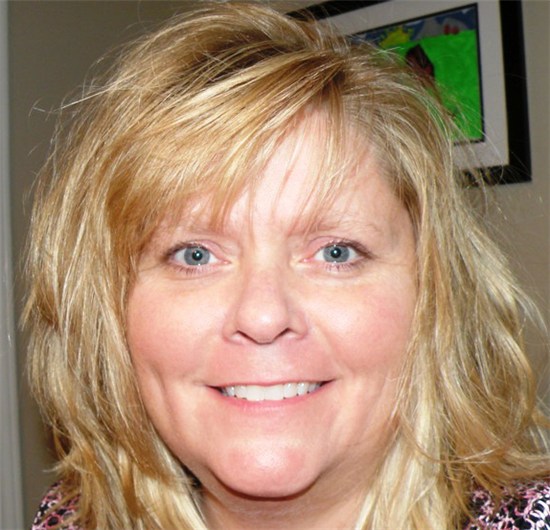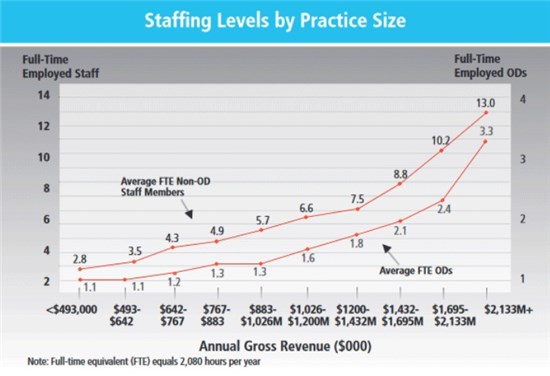By Stuart J. Thomas, OD,
and Ellen Byrum-Goad, LDO
April 6, 2016
SYNOPSIS
Manage staff schedules and cross-train for an efficient office where costly service breakdowns are minimized.
ACTION POINTS
ESTABLISH RESPONSIBILITY CULTURE. Staff should understand that patient care and service are top priorities when making scheduling requests.
SHARE DOCTOR SCHEDULE. Let staff know when your doctor(s) will have a heavy schedule, or when they have a light schedule or are out of the office entirely.
CROSS-TRAIN. Cross-train employees in each others’ duties so they can seamlessly fill in when a co-worker is unexpectedly out of the office. Eliminate losses and staff stress.

Staff is keyto delivering an outstanding level of care and service that builds a practice. Even one staff member unexpectedly absent can send an office into a financial tailspin. Very quickly,poor staff scheduling can kill a practice.
Non-OD staff in a typical optometric practice is about 20 percent of gross revenue. As a practice grows, effectively managing work schedules and employment protocolsis essential to a smooth working practice. Staff needs to be present and on time, well trained in their area and cross-trained in others, and motivated–so that they are part of delivering a team message about outstanding care and value. In our practice, we have a system to proactively make that happen.
Our practice has one OD and eight full-time employees, and for our office to runefficiently, we need to beadequately staffed at all times to deliver the kind of patient experience we strive for.
Research from the Management and Business Academy, showing staffing levels according to practice size. Dr. Thomas and Byrum-Goad say they work hard to ensure adequate staff is available on all days the doctor is in the office, and that they let employees know before they are hired about the hours and days they will be expected to work.
Establish Culture of Responsibility to Patient Care & Service
Staff members who understand that patient care is king, and patient experience is queen, understand that we have to have people here to serve those who choose us. Being tardy is never acceptable in our office, and we set the standard for consistent, on-time performance from each employee’s first day of work.
We might tell a new employee: “In our office we have a very high standard for punctuality. Our level of patient care, and what we create for each patient experience, demands that all employees be on time and ready to serve those who choose us to deliver their care. Being tardy is simply unacceptable and won’t be tolerated. We can’t stress this enough. You have signed and read our policy manual, and I want to specifically go over this policy with you. Do you have any questions?”
It is essential to be clear on expectations and firm on consequences of poor performance.
When an employee, nevertheless, comes in late, we might say to them: “(Insert employee name), we discussed our employee tardy policy outlined in our manual upon your hiring. You signed, and were fully aware, of that policy and the consequences of breaking that policy. Is there anything I need to explain further to help you understand that policy? What will you do in the future to make sure you adhere to the policy?” This discussion is then followed up by a counseling memo, which re-states what each party had to say. Everyone signs and dates it.
Share Doctor Schedule with Employees
We demand a 40-hour work week of all full-time employees. They know to look ahead on the schedule to make personal appointments when the doctor is not in the office seeing patients. If the day ends early (which is rare) someone is always happy to cut out a little early.
When the doctor is seeing patients, it is all hands on deck!
Thepractice web site at Thomas Eye Center introducesstaff to patients and sets a friendly tone. Offering personalizedservice–and having a happy, motivated staff–is a practice differentiator.
Cross-Train to Allow for Greater Flexibility
The key to success is having staff that is cross-trained so they can walk into another area of the practice and seamlessly pitch in. Most of us have kids, so we ask all employees to have a back-up daycare or sitter. We recognize the huge impact on patient service and sales having even one employee unexpectedly out of the office can make. It might mean fewer sales of premium eyewear, or a missed opportunity to upgrade a patient’s sunwear to polarized prescription lenses.
However, we can usually accommodate the changes to schedules that staff members need because of their cross-training. For instance, one of our employees just started sending her 2-year-old to daycare. We talked about the fact that daycare kids get a little sicker, and when pink eye hits the daycare, he may be required to be out a day or two. We know in advance that we will be accommodating this employee’s needs as they arise.
Stagger Arrival & Departure Times
All staff are scheduled Monday through Friday, but we stagger their arrival and departure times. Our first employee assigned to front desk check-in works 7:45 a.m. to 4:45 p.m. The next front desk employee comes in at 8:15 a.m. to 5:15 p.m., and then the final front desk person arrives at 8:30 a.m., and that person closes out the day.
Our 7:45 a.m. arriving front-desk employee is cross-trained as a pre-testing technician also, so they are ready for the 8 a.m. patient when they walk through the door.
All front desk staff are also trained to check in and check out, including our opticians. One optician works 8:15 a.m. to 5:15 p.m. to be there when our first patient arrives, and the other optician arrives at 8:30 a.m. and works until closing time.
We are not currently open on the weekends, but when staff is hired, they are told that in the future weekend hours may be a possibility, so that we can keep our options open.
Anytime staff needs to make an adjustment to their set schedule, they are allowed to do so themselves in our practice management system and simply inform us by e-mail, with all other employees copied.
Use Time Clock Software
New technology that measures time in the office can improve performance–and accountability.
The time clock software program we use is called Lathem PayClock V6. Time clock is digital and mounted near my desk. Beside it hangs business card-size time cards. They have to be waived in front of the clock to make it beep. It then says “Hello,” or “Goodbye,” depending on whether you are clocking in or clocking out.
We used to track staff time in and out by having staff sign in and out on a piece of paper. But it was unreliable. Some employees would write that they were on time every day when they clearly weren’t. Or they would write in a time that was later than when management thought they had actually left. To get rid of any question, we went to a digital time clock and the arguments ceased.
Limit Need for Over-Time Pay
We make sure employees are staying aware of their end times and work to finish their tasks accordingly, so that they don’t run over and incur overtime. Over-time pay is a financial hemorrhage for an office if left unchecked. We want to take care of those who choose us – our patients, while being able to offer our staff a consistent number of work hours every week. If we stay organized and efficient enough to limit the need for over-time work, there is less chance we will need to cut hours when the doctor is out of town.
First Come First Served for Vacation Days
My (Byrum-Goad) calendar is literally first come – first serve. You request it – I put you on the calendar – done! I have had someone scheduled off and another employee was able to get a hair appointment with a fabulous new hairdresser in town, and suddenly wanted the day off. It was years ago, but I remember it well. The one who was first on the calendar won. Then there are the employees who ask for Thanksgiving and Christmas off the minute that they see you set up the next calendar. I quelled that by stating that you can only request time off four months in advance unless you are having a major life event such as a wedding or the birth of a child.
The biggest disputes come from the people who “forget” to clock back in from lunch (usually because they are late and they don’t want to be penalized for being tardy). To avoid these disputes, forgetting to clock in is considered by us the same as being late.
Doctor and Staff Manager: Who Does What?
Delegates Staff Scheduling
The office manager (Ellen) keeps up with all requests for time off, vacation and staff scheduling. When it looks like we are going to have an extended time where the doctor (Dr. Thomas) will be out of the office, then the office manager takes her vacation at that point, and offers it up to employees as a good time for some of them to take a vacation, too. We leave a minimum of three people in the office when Dr. Thomas is out. One front desk, one in the optical and one who can float and help in both areas.
Stuart J. Thomas, OD, is the owner of Thomas Eye Center in Athens, Ga.
Contact: StuTh2@vsp.com
Ellen Byrum-Goad, LDO, is practice manager. To contact: Ellen.Goad@thomaseyecenter.com





























